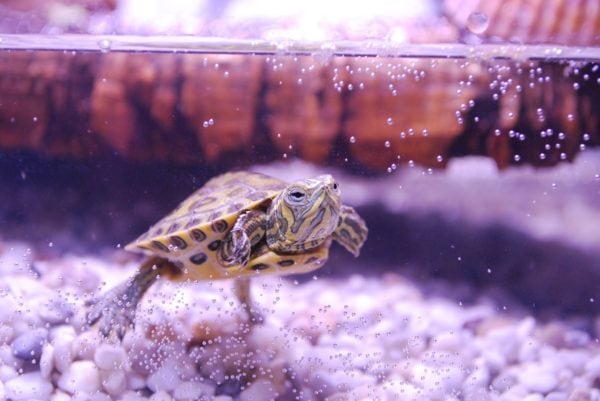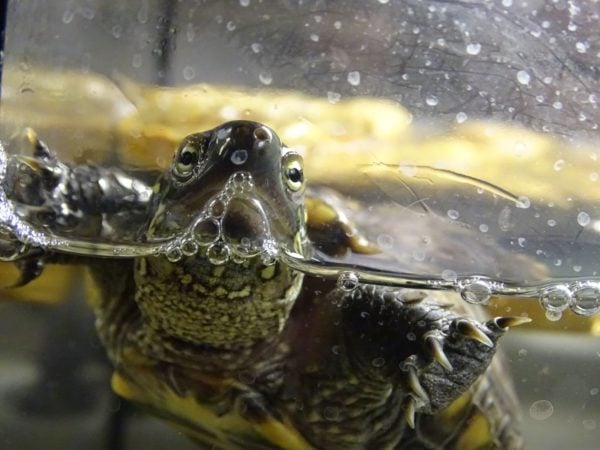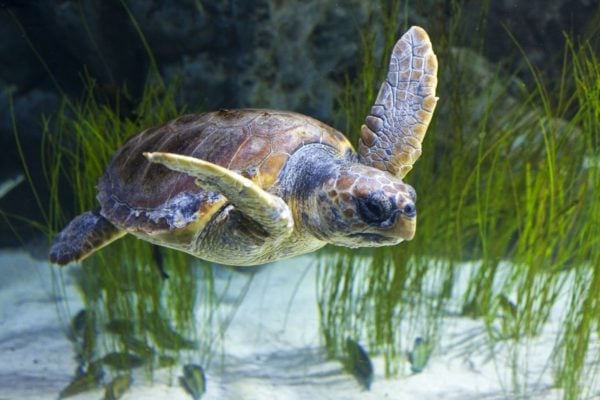Turtles are aquatic animals and as pets, they swim around the tank and thrive in a well-maintained habitat. But there are times when you notice that your turtle may be floating in the water. Based on their condition at the time of the floating coupled with other symptoms, you can zero down on the reason for your turtle floating.
Read all about taking care of your pet turtle here:
Table of Contents
Why Is My Turtle Floating? [Major Reason]
Your turtle might be floating because it is taking a nap or because it is inactive. Turtles also float because they have gastrointestinal problems that cause them to move up and down and float. In some extreme cases, turtles also float because they have a respiratory illness.
What Causes Turtles To Float?
Usually, your turtle could be floating around swimming as usual and it’s not necessary to raise an alarm over it. Especially when it’s floating just above the substrate or in the middle of the tank, don’t get alarmed at the level of inactivity. Your turtle could be just taking a snooze or a well-deserved moment of inactivity. However, sometimes you may notice that your turtle is floating on the surface of the water in the tank. That is when it is essential to check it out properly.
Most often than not, the gas build-up could cause the turtle to float on the surface of the water. To check whether it’s just gas or something more serious, you can do a simple test. Gently push the turtle with your finger while it’s floating, if it bounces back like a balloon bobbing on the water, it implies that your turtle could be suffering from something more serious than a gas build-up.

Gastrointestinal Issue
When a turtle has gastrointestinal issues or discomfort due to gas build-up, the turtle tends to move and bounce up and down. You will notice it tilting its head to its tail. In such a case, when the turtle is floating and showing signs of gastric discomfort, the best thing would be to wait it out as the issue tends to fix itself. If the gas build-up keeps recurring frequently, it is suggested that the turtle be put on a diet of a lot of antioxidants. A readily available fruit and vegetable mix are a great choice of feed in such a scenario.
While floating due to gas is quite common in domesticated turtles, they can cause a volley of problems for the turtles in the wild. Although gas does rectify itself, in the wild turtles tend to float near the surface due to eating the marine debris and bloating. This gas makes them unable to swim back downstairs to feed making them lethargic and slow. Also, they become ready food for predatory fishes like whales and sharks that float on the upper levels of the sea.
Why Turtles Float Due To Gas?
It is imperative to note before making up the worst scenarios in your head that your turtle could float due to a lot of smaller issues. Yes, logic dictates that the worst be assumed but most times your turtle could be facing gastrointestinal issues following which it feels bloated and hence, floats. Gas build-up happens when new food is introduced into the turtle’s diet. There could be gastrointestinal issues even if the turtle has started certain new medications.
When the turtle is introduced to a new food group or they start a certain new medication, it tends to block up their gastrointestinal tract and results in the formation of gas. The resultant gas and bloating make the turtle floating in the water.
Ever wondered how long the red-eared slider turtle lives in captivity? Read all you need to know about it here:
Respiratory Illness
There is a condition of floating known as listing which means bouncing from one side to the other or just floating sideways. If you notice that your turtle is listing, that calls for some more investigation into its health. Chances are that your turtle is Suffering from a respiratory illness.
Just like humans, turtles too breathe through a pair of lungs. respiratory infections in Turtles are caused by various reasons. One of the most important factors of respiratory illnesses in Turtles is the presence of various microorganisms in the tank-like bacteria and fungus. The prevalence of these microorganisms in the tank can be tracked down to I’ll maintain tank environment, dietary discrepancies, lack of tank hygiene, and lack of proper heat in the tank.
Why Do Turtles Float Due To Respiratory Infections?
The physiological makeup of the turtle’s lungs is very similar to the human lungs. These infections and respiratory problems cause the water to get filled in the lungs thereby resulting in the turtle floating in the water due to its inability to breathe and swim. In most cases, turtles floating on the surface, especially sideways, are a clear indication of advanced stages of respiratory infection.
Symptoms Of Respiratory Infection
Identifying the nature and the reason for the turtle floating in the water is most crucial. If you witness mucus foaming out of your turtle’s mouth and nose, most likely it indicates the onset of a respiratory illness. There may also be bubbles spouting out of its mouth and nose. Detecting a respiratory illness in a turtle early on is very crucial so that it can be treated in time. As the illness intensifies, it tends to develop into serious pneumonia out of which a turtle can rarely be revived.

Infections relating to the lung can be caused by a variety of microorganisms like bacteria, viruses, and fungi. The propagation of these organisms in the tank becomes possible if optimal conditions are not maintained. Lack of heat and the absence of UV light can result in the growth of infection-causing microorganisms. Along with that, if the water in the tank is too chilly or has a draft of air hitting it constantly, it is said to cause infections in the turtle. Vitamin A deficiency caused by poor dietary intake can also cause the lungs to weaken and succumb to illnesses quickly. Last but not the least, the hygiene and sanitation of the tank also play a major role in the growth of disease-causing organisms.
How Can I Prevent A Respiratory Disease?
It is established that respiratory illnesses in turtles can be nothing short of a disaster. To prevent such illnesses from occurring, there are certain steps that a pet owner can take vigilantly.
While discussing the causes of respiratory illnesses, it has been noticed that poor diet, hygiene, lack of heat and light are the chief contributors to the infections. So, as a mode of preventing the illness from happening, one must try and follow guidelines to maintain them optimally.
The tank must be well maintained and cleaned regularly. A powerful water filter can be used to clean the water and maintain the desired pH levels in the water.
A UV lamp needs to be attached to the tank. It serves the double purpose of providing warmth to the turtle and helping it in the production of vitamin d3 that aids in the absorption of calcium in their body. The UV lamp also helps the turtle to bask and dry their shells when need be. It is advised to keep the UV lamp lit over the tank for about 10 to 12 hours a day. Even when the lamp is turned off, it needs to be made sure that the temperature does not fall below 50 degrees Fahrenheit.
In terms of nutrition, vitamin a is most important for good respiratory health. Include vitamin-rich foods in the turtle’s diet, like carrots, sweet potatoes, and dark green leafy vegetables. If need be, you can also use supplementation to meet their nutritional needs.
Making sure that the water is balmy 50 degrees Fahrenheit or more is another important factor for ensuring good tank habitat. Measures have to be taken to make sure that the water does not get too chilly or there are no drafts of air that hit the water.
Why Is My Turtle Floating Sideways?

When there is a gas build-up or the gastrointestinal tract is blocked in a turtle, they tend to float sideways. In the case of gas, it does get rectified on its own and the turtle goes back to floating and swimming normally. So there is no need to raise an alarm if the turtle seems to be floating sideways a couple of times and straightening back up. But in case the turtle is listening continuously, that is bouncing from one side to the other constantly, and is also secreting mucus from its mouth and nasal cavity, you must immediately consult a vet and get the turtle checked out.
If at any point, you notice the turtle is floating on its side and is unable to submerge itself back in the tank, it means that its lungs have been filled up with water and the respiratory infection is in its advanced stage. In most cases, these respiratory illnesses manifest as pneumonia if not treated early on.
Why Is My Turtle Floating Upside Down?
It is unnatural for the turtle to float upside down. There are a variety of reasons that can lead for a turtle to be on its back and some of the reasons may just be physiological. Usually, when the turtle is upside down, they correct themselves after a while. A faulty habitat setup or shallow waters in the tank may cause the turtle to turn over and float on its back. Although, if you notice that the turtle has been on its back for way too long, it is important to get in touch with your vet as soon as possible.
Due to lack of swimming space, a turtle may end up getting flipped over. So when you see your turtle floating in a position that it shouldn’t, check for your tank habitat. If your turtle has been eating well and has a good temperament, most likely the aquarium setup is to blame. The depth of the water also needs to be more than the width of the tank for the turtle to thrive and swim well.
Another reason why turtles could be found floating on their backs is due to the presence of aggressive tank mates. In the presence of a female turtle, the male turtles could get into a fight, especially during the mating season. The strong male turtle could flip over the weaker turtle in a show of strength.
FAQ’s
Yes, Turtles float and there could be a lot of varied reasons for why it does. Usually, if the turtle is floating just above the substrate or the floor of the tank it is swimming or snoozing. Other factors that cause the turtle to float are gas build-up or a respiratory infection. A faulty tank setup or housing multiple turtles could also cause the turtle to float.
Like all animals, turtles too go through the process of decomposing when it dies. They start to bloat and emit foul-smelling odor from the minute they pass away. Although the process of decomposition kicks in, turtles do not bloat till about 12 to 30 hours later. It is the bloating that makes them float in the water.
Summary
Turtles require special care and tank maintenance, read all about it here:
Given all the reasons, under any circumstances when you notice your pet turtle floating in the tank, it is highly recommended to consult your vet and get it checked out. Most likely it is either gas or a respiratory illness. Although gas is a very normal occurring and cannot be avoided, respiratory infections can be completely prevented if taken adequate care.
